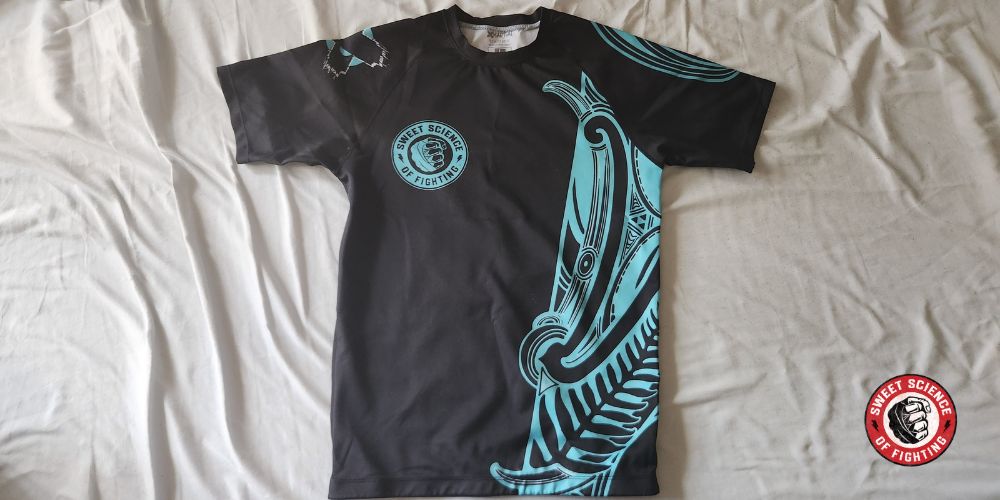Just like wrestlers wear singlets and judokas and BJJ guys wear gis, no-gi grapplers have a more modern uniform called a rash guard. You’ve seen tight, spandex-looking shirts, some made with bold colors, showcasing gym logos, or having complete works of art on them. But aren’t compression shirts just the same but without the cool looks?
BJJ rash guards and compression shirts are similar because both are tight-fitting and made from synthetic materials. But rash guards are more durable, better made, and often have attractive BJJ-related designs.
Compression shirts are much cheaper than rash guards, so you may wonder if the price difference is worth it.
What Is A Rash Guard
A rash guard is a form-fitting synthetic shirt that protects the skin from rashes, bruises, abrasions, and infections. Initially, rash guards were meant for surfers who wanted to protect their skin from the sand, salt, and sun, but other active people gradually adopted them. The significant benefactors of the rash guard invention, though, were the BJJ and MMA crowds.
Grappling with dozens of other sweaty people on drenched mats creates a surplus of dangers for the skin. In the gym, the enemy is not the sun and the sand but the germs and bodily fluids lurking on the mats, which can cause superficial skin damage like mat burn.
A rash guard protects not only your skin but also that of your training partners. It keeps away infections, sweat, and hair.
Because rash guards fit the body like a glove, they are superior to regular t-shirts, which can roll up or get a limb entangled in the fabric. Rash guards are sweat-wicking and do not stick to the body like a cotton shirt. They also dry up much quicker.
The rash guard has become the uniform for every no-gi grappler. Still, many people prefer using them even underneath their BJJ gis because of all the protective qualities of rash guards, plus the bonus they soak up some of the sweat that would otherwise go on the precious and expensive gi.
Is A Compression Shirt The Same As A BJJ Rash Guard?

With all the above points said, you might think a rash guard is just a BJJ-branded compression shirt. After all, compression shirts are tight-fitting, synthetic clothing that looks very similar but is at least half the price. While this is true on the surface, there are differences between the two that more or less justify the price difference.
Materials
While both rash guards and compression shirts are made from blends of polyester, spandex, or other synthetic materials, the quality and quantity are somewhat different. A good rash guard is always much thicker, with higher-quality fabric used.
Compression shirts are lightweight, provide good muscle support, and are breathable and sweat-wicking. In addition to those features, the extra material in a BJJ rash guard makes it significantly more durable.
The constant friction with the mats and other bodies means rash guards go through a lot more wear and tear. This is why they are made with thicker material than compression shirts.
Rash guards often have factory-applied antibacterial treatment, which reduces the chance of infections and prevents the growth of odor-causing bacteria.
Stitching
Another key difference stemming from the same necessity for durability is the stitching and type of seam. Rash guards often have flatlock stitching, meaning the seams are flat at the overlapping pieces of fabric. The seams rest flat on the skin and present no discomfort, while at the same time, chaffing is much more unlikely.
There are other types of stitching used in rash guards, but in all cases, they are reinforced, unlike in compression shirts, where the expected friction is much less, and there is no need to do the extra production work and raise the price.
Features
Rubber waistbands are A prominent feature in higher-class BJJ rash guards but completely missing from compression shirts. They do an excellent job of keeping the rash guard in place, regardless of the crazy positions and scrambles you may find yourself in while rolling.
This may not sound like a big deal, but once you try a rash guard with an anti-slip waistband, it will become a feature you want in every new one you buy.
Good compression shirts sometimes have mesh underarms or sides, which is an excellent feature for many sports but not for BJJ.
Design
A part of the high price of BJJ rash guards is indeed just branding and marketing. But you cannot deny that rash guards look super cool, and there are infinite choices when it comes to visuals. Some of those visuals have taken a long time and thought to be designed, which is naturally accounted for in the price tag.
Compression shirts, on the other hand, are usually plain and unicolor. While this is not bad, a nice BJJ rash guard will earn you many style points. In addition, it can be branded with the name of the academy, the logo, or any other personal visuals reflecting your style and personality.
Graphics on rash guards are also sublimated, meaning they are directly dyed into the fabric and will never crack or peel over time. Compression shirts usually don’t have graphics, which is another reason they are cheaper.
Can I Use A Compression Shirt For BJJ?
Some people and articles may have you think there is no other option to train no-gi BJJ without a rash guard, but this is not entirely true.
A proper BJJ rash guard outperforms a compression shirt at every level, but the second option can still be used for training. Especially when you are a beginner, grabbing a cheap compression shirt is enough to get you started before deciding whether you need to invest in rash guards later.
A regular compression shirt might be enough if you are doing only gi. Especially if the gym enforces wearing something underneath the gi, there is no point in spending extra dollars on a well-designed, super-durable rash guard that will neither be visible nor withstand a lot of stress.
Some people even train with regular cotton t-shirts, and while it’s not the most comfortable or safe way, there are only so many gyms that will stop you from attending class if you don’t wear a rash guard (but there are some).
The most important thing is to wear something comfortable and well-fitting to practice. A rash guard is superior to any other clothing because it’s designed with grappling in mind, but you can get away with training with a compression shirt or even a regular cotton one.
BJJ Rash Guard vs. Compression Shirt Summary
To summarize the key differences between rash guards and compressions shirt, here are the main advantages of both.
BJJ Rash Guard Advantages
- Durability– rash guards are made with thicker, more durable materials. A good rash guard may last for years without tearing or fraying, even after all the wear on the mats and constant washing. All rash guards have reinforced stitching for that purpose.
- Protection- BJJ rash guards provide excellent protection for the skin against rashes, mat burs, and training partners’ bodily fluids.
- Style- Rash guards have unique designs allowing you to express your personal style or represent your gym or team.
- Fit- a properly fitting rash guard is always very snug and usually provides better compression than compression shirts. The fit is also important for grappling; the tight fit ensures the attire does not ride up.
- Regulation- If you compete in no-gi grappling, you must respect the regulations for the specific event and wear a compatible rash guard.
Compression Shirt Advantages
- Price- All rash guards’ benefits and extra features come at a price. A good rash guard usually costs double, triple, or quadruple the price of a regular compressions shirt you can find at any sports store. The much higher price makes rash guards not affordable for everyone.
- Comfort- Compression shirts are much lighter than rash guards, which some practitioners prefer, especially during summertime in gyms without air conditioning.
As you see, the advantages of rash guards are significant to those of compression shirts for BJJ and grappling practice in general. They have become universal in gyms worldwide for a good reason, and if you are serious about training, I suggest you spend the extra bucks and buy a few good quality rash guards.

